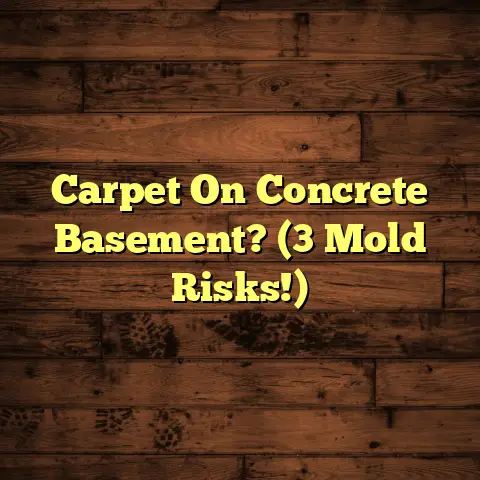Bamboo Flooring Outside? Read First! (9 Mistakes!)
Think bamboo flooring is a sustainable, stylish choice for your outdoor oasis? Think again!
Before you make the leap, it’s crucial to understand the nine critical mistakes that can turn your dream patio into a costly disaster.
I’ve seen it happen too many times: homeowners excited about the eco-friendly appeal of bamboo, only to face a rotting, warped mess months later.
Don’t let that be you. Let’s dive into what you really need to know before even considering bamboo flooring for your outdoor space.
Section 1: Understanding Bamboo Flooring
What is Bamboo Flooring, Anyway?
Bamboo flooring isn’t actually wood. It’s a grass! That’s right, bamboo is a highly renewable resource that grows incredibly fast.
This rapid growth makes it a popular choice for those seeking sustainable building materials. But here’s where things get interesting: not all bamboo flooring is created equal.
It’s typically manufactured by slicing the bamboo stalks into strips, then bonding them together under high pressure with adhesives.
There are three main types:
- Horizontal: Strips are laid flat, showing the bamboo’s knuckles.
- Vertical: Strips are oriented on their edges, creating a cleaner, lined appearance.
- Strand-Woven: Bamboo fibers are shredded, then compressed and glued. This is the densest and most durable type.
The Allure of Bamboo: Why It’s So Popular
Bamboo’s popularity stems from a few key factors:
- Sustainability: It’s a rapidly renewable resource compared to hardwoods.
- Aesthetics: It offers a unique, modern look.
- Cost: It can be more affordable than some hardwood options (though not always!).
- Strength: Strand-woven bamboo, in particular, can be surprisingly strong.
I’ve seen bamboo used beautifully in interiors, adding a touch of natural elegance to homes. It’s a great choice for living rooms, bedrooms, and even kitchens (with the right sealant).
Why the Outdoor Temptation?
Given its indoor success, it’s no surprise homeowners are tempted to extend bamboo’s stylish look to their patios, decks, and pool areas. Imagine a seamless transition from your indoor living space to a serene bamboo deck…sounds great, right?
Unfortunately, the reality is often far from the dream. The outdoor environment presents challenges that most bamboo flooring simply isn’t equipped to handle without serious precautions.
Section 2: Mistake #1 – Ignoring Weather Resistance
The Weather: Bamboo’s Arch-Enemy
This is the biggest mistake I see. People assume that because bamboo is strong indoors, it can withstand the elements. Wrong!
Think about it: your outdoor flooring is constantly bombarded with:
- Moisture: Rain, snow, humidity, splashing from the pool.
- UV Rays: The sun’s intense rays can fade and damage the bamboo.
- Temperature Fluctuations: Extreme heat and cold cause expansion and contraction.
These factors can wreak havoc on bamboo if you’re not prepared. The biggest culprit? Moisture.
Bamboo is naturally absorbent. Without proper protection, it will soak up water like a sponge, leading to:
- Warping: The boards will bend and twist.
- Swelling: The bamboo will expand, causing buckling and lifting.
- Rotting: Mold and mildew will thrive, destroying the flooring from the inside out.
Untreated Bamboo: A Recipe for Disaster
Untreated bamboo is simply not suitable for outdoor use. It’s like leaving a sponge out in the rain – it’s going to get soaked and fall apart.
Even seemingly “water-resistant” bamboo can suffer without the right protection. The adhesives used to bind the bamboo strips can break down with prolonged exposure to moisture.
What Kind of Bamboo Can Work Outdoors?
While I generally advise against it, if you’re dead-set on using bamboo outdoors, you must choose a specific type designed for exterior use.
Look for bamboo that has been:
- Specifically treated for outdoor use: This usually involves a pressure-treating process with preservatives.
- Made with marine-grade adhesives: These adhesives are designed to withstand constant moisture exposure.
- Strand-woven: This type is denser and less absorbent than horizontal or vertical bamboo.
Even with these precautions, remember that outdoor bamboo flooring will require significantly more maintenance than indoor bamboo or other outdoor flooring options.
Section 3: Mistake #2 – Choosing Inappropriate Finishes
Finish First Impressions
The finish on your bamboo flooring is your first line of defense against the elements. Choosing the wrong finish is like sending your soldiers into battle without armor.
Many homeowners mistakenly believe that any exterior wood finish will work on bamboo. This is a dangerous assumption.
Most standard wood finishes are not designed to handle the specific properties of bamboo. They may not adhere properly, crack easily, or offer sufficient UV protection.
The Wrong Finishes: A Costly Error
Here are some finishes you should avoid for outdoor bamboo:
- Interior-grade polyurethane: This will crack and peel quickly in the sun and rain.
- Oil-based finishes: While they offer some water resistance, they can darken and become brittle over time.
- Varnish: It’s not flexible enough to handle the expansion and contraction of bamboo.
I’ve seen decks with these finishes fail within a single season, leaving homeowners with a peeling, unsightly mess.
The Right Kind of Armor: Exterior Finishes
So, what should you use? Look for finishes specifically designed for exterior use and recommended by the bamboo flooring manufacturer.
Here are some options that offer better protection:
- Marine-grade spar varnish: This is a flexible and durable finish that can withstand harsh weather conditions.
- Exterior-grade polyurethane with UV inhibitors: Look for a product specifically formulated for outdoor use and containing UV absorbers to prevent fading.
- Penetrating oil finishes: These oils soak into the bamboo, providing water resistance from within. They require regular reapplication.
Important: Always follow the manufacturer’s instructions for application and maintenance. Multiple coats are usually necessary for adequate protection.
Section 4: Mistake #3 – Skipping Proper Installation Techniques
Installation: The Foundation of Success (or Failure)
Even with the right bamboo and the right finish, improper installation can doom your outdoor flooring project. Bamboo expands and contracts with changes in temperature and humidity.
If it’s installed too tightly, it will buckle and warp. If it’s installed too loosely, it will shift and create gaps.
Common Installation Pitfalls
Here are some common installation mistakes I see:
- Failing to leave expansion gaps: This is critical! Leave adequate space between the boards and around the perimeter of the deck to allow for expansion.
- Using the wrong fasteners: Use stainless steel screws or hidden fastener systems designed for outdoor use. Galvanized nails will rust and corrode.
- Ignoring proper subfloor preparation: The subfloor must be level, dry, and well-ventilated. Poor drainage will lead to moisture problems.
- Not acclimating the bamboo: Allow the bamboo to acclimate to the outdoor environment for several days before installation.
Hire a Pro (or Follow Instructions Meticulously)
Installing outdoor bamboo flooring is not a DIY project for beginners. I strongly recommend hiring an experienced professional who is familiar with bamboo and outdoor construction.
If you’re determined to do it yourself, be sure to:
- Read the manufacturer’s instructions carefully.
- Watch instructional videos.
- Take your time and double-check your work.
- Don’t be afraid to ask for help.
Section 5: Mistake #4 – Neglecting Maintenance Requirements
Maintenance: The Ongoing Battle
Outdoor bamboo flooring requires significantly more maintenance than indoor bamboo or other outdoor flooring options like composite decking.
Think of it as a constant battle against the elements. You need to be vigilant about cleaning, sealing, and repairing any damage.
Common Maintenance Mistakes
Here are some common mistakes homeowners make:
- Ignoring regular cleaning: Dirt, debris, and algae can build up on the surface, trapping moisture and promoting rot.
- Using harsh cleaning chemicals: These can damage the finish and the bamboo itself.
- Delaying repairs: Small cracks and chips can quickly turn into larger problems if left untreated.
- Skipping annual resealing: The finish will wear down over time, leaving the bamboo vulnerable.
Seasonal Care Tips
- Spring: Clean the flooring thoroughly and inspect for any damage. Apply a fresh coat of sealant.
- Summer: Sweep regularly to remove dirt and debris. Monitor for signs of fading or wear.
- Fall: Remove leaves and debris promptly. Prepare the flooring for winter by applying a water-repellent sealant.
- Winter: Clear snow and ice carefully to avoid damaging the surface.
Regular Upkeep: Your Best Defense
Regular maintenance is the key to extending the life of your outdoor bamboo flooring. Here’s a recommended schedule:
- Sweep or vacuum: Weekly
- Wash with mild soap and water: Monthly
- Inspect for damage: Monthly
- Reapply sealant: Annually
Section 6: Mistake #5 – Overlooking Moisture Management
Moisture: The Silent Killer
I’ve already touched on the importance of weather resistance, but moisture management deserves its own section. Moisture is the biggest threat to outdoor bamboo flooring.
Even with a good finish, moisture can still seep into the bamboo through cracks, gaps, and the underside of the boards.
The Risks of Mold and Mildew
When bamboo stays wet for extended periods, it creates the perfect breeding ground for mold and mildew. These fungi can:
- Discolor the bamboo: Causing unsightly stains.
- Weaken the structure: Leading to rot and decay.
- Pose health risks: Triggering allergies and respiratory problems.
Drainage is Key
Proper drainage is essential for preventing moisture accumulation. Make sure your deck or patio is sloped slightly to allow water to run off.
Moisture Barriers: An Essential Layer
A moisture barrier is a layer of waterproof material that is installed beneath the bamboo flooring to prevent moisture from rising up from the ground.
Common options include:
- Polyethylene sheeting: A simple and affordable option.
- Rubber membranes: More durable and resistant to tearing.
- Liquid-applied membranes: Provide a seamless and waterproof barrier.
Ventilation: Let It Breathe
Proper ventilation is also crucial. Make sure there is adequate airflow beneath the deck to allow moisture to evaporate.
Section 7: Mistake #6 – Failing to Consider Temperature Changes
Temperature Swings: A Constant Stress
Bamboo expands when it’s hot and contracts when it’s cold. These temperature changes can put a lot of stress on the flooring, especially if it’s not properly installed.
Thermal Expansion: The Unseen Force
Failing to account for thermal expansion can lead to:
- Buckling: The boards will push against each other and warp upwards.
- Cracking: The bamboo will split and crack under pressure.
- Fastener failure: Screws and nails can pull out or break.
Mitigating the Risks
Here are some ways to mitigate the risks of temperature changes:
- Leave adequate expansion gaps: This is crucial! The wider the temperature range, the larger the gaps need to be.
- Use flexible adhesives: These adhesives allow the bamboo to move without cracking.
- Choose a location with moderate temperatures: Avoid areas that are exposed to extreme heat or cold.
Section 8: Mistake #7 – Not Assessing Sun Exposure
The Sun’s Damaging Rays
Direct sunlight can be brutal on bamboo flooring. The sun’s UV rays can:
- Fade the color: Causing the bamboo to look washed out and dull.
- Dry out the bamboo: Making it brittle and prone to cracking.
- Damage the finish: Causing it to peel and crack.
- Heat Damage: Causing burns on the surface and making it uncomfortable to walk on.
Location, Location, Location
Choosing a location with limited sun exposure is the best way to protect your outdoor bamboo flooring.
Consider:
- Shade trees: Plant trees to provide shade during the hottest part of the day.
- Awnings and umbrellas: These can provide temporary shade when needed.
- Overhangs: A roof overhang can protect the flooring from direct sunlight.
UV Protection: Your Shield Against the Sun
Use a finish that contains UV inhibitors to protect the bamboo from the sun’s harmful rays. Reapply the finish regularly to maintain its protective properties.
Section 9: Mistake #8 – Choosing the Wrong Type of Bamboo
Bamboo Species: Not All Created Equal
There are over 1,000 species of bamboo, but not all of them are suitable for flooring, let alone outdoor use.
Misconceptions About Durability
Don’t assume that all bamboo is created equal. Some species are naturally stronger and more durable than others.
High-Quality Bamboo: The Key to Longevity
Choose high-quality, strand-woven bamboo that has been specifically treated for outdoor use. Avoid low-quality bamboo that is likely to warp, crack, and rot.
Selecting the Right Bamboo Species
Here are some bamboo species that are known for their durability and suitability for flooring:
- Moso Bamboo: A strong and durable species that is commonly used for flooring.
- Guadua Bamboo: A large and strong species that is often used for construction.
- Tiger Bamboo: A visually striking species with a unique striped pattern.
Section 10: Mistake #9 – Ignoring Local Climate and Conditions
Climate Matters: What Works in Florida Might Not Work in Alaska
The climate in your area will have a significant impact on the performance of your outdoor bamboo flooring.
Research Local Weather Patterns
Before you install bamboo flooring, research the local weather patterns and consider how they will affect the flooring.
Climate-Specific Recommendations
Here are some climate-specific recommendations:
- Humid climates: Choose a bamboo that is resistant to mold and mildew. Ensure proper drainage and ventilation.
- Dry climates: Use a finish that will prevent the bamboo from drying out and cracking.
- Cold climates: Choose a bamboo that is resistant to freezing and thawing. Ensure proper insulation.
- Sunny climates: Use a finish that contains UV inhibitors to protect the bamboo from the sun’s harmful rays.
Conclusion: Recap of the Nine Mistakes
So, there you have it: the nine critical mistakes homeowners often make when considering bamboo flooring for outdoor use.
Let’s recap:
- Ignoring Weather Resistance
- Choosing Inappropriate Finishes
- Skipping Proper Installation Techniques
- Neglecting Maintenance Requirements
- Overlooking Moisture Management
- Failing to Consider Temperature Changes
- Not Assessing Sun Exposure
- Choosing the Wrong Type of Bamboo
- Ignoring Local Climate and Conditions
Remember, being informed and proactive is key to ensuring a successful and sustainable outdoor flooring project.
While bamboo can be a beautiful and eco-friendly option, it’s not always the best choice for outdoor use. Consider all the factors carefully before making a decision.
If you’re still unsure, consult with a qualified flooring contractor who can assess your specific needs and recommend the best flooring solution for your outdoor space.
Good luck, and happy building!





